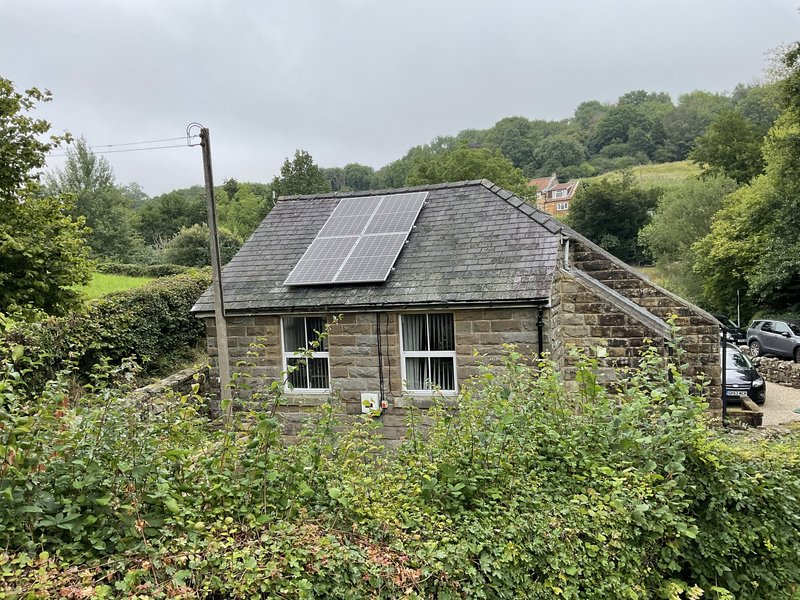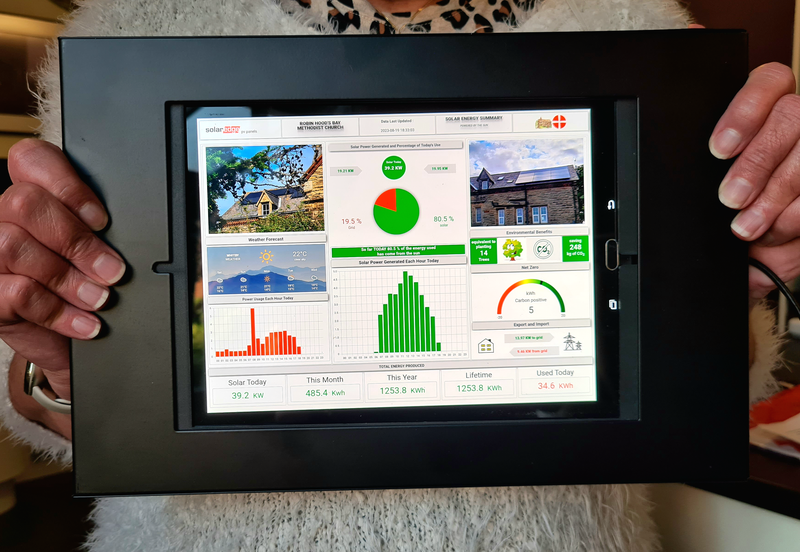08 November 2023
Churches in Yorkshire North & East Methodist District go solar
The Yorkshire sun now rises over seven new churches with photovoltaic panels on their roofs. Installed over the past few months as part of the district’s Tea & PV project, the panels will help the district reach its net zero emissions targets and cut costs.
The Tea & PV Project will officially be launched at Portholme Church on 10 November, with MP Keir Mather cutting the ribbon.
Photovoltaic panels (PV) have been installed on churches in the Yorkshire North & East Methodist District including the rural Sewerby, Littlebeck and Robin Hood's Bay, and the suburban Portholme in Selby. Four buildings were initially fitted with the panels to assess their performance. All the churches are buzzing community hubs with high – but varied – footfalls serving their communities in different ways, from Scouts to blood donation and talking newspapers. The churches were pillars of their communities and will make good use of the money saved on the electricity bills and reinvest it locally.
Portholme and Sewerby – the latter being part of the new Bridge Circuit – were high on the shortlist for the Tea & PV project as they were quite far into their net zero journeys with improved insulation and energy efficiency measures put in place some time ago.

Sewerby is a town situated along the coast and experiences a significant increase in population during the summer months with an influx of tourists and second homeowners. The church has been facing a challenge in heating its building as it relies solely on electricity, which has become unaffordable in recent years. “For the last ten days, we've pulled one kilowatt hour from the mains grid, the rest is all generated ourselves. We are now generating more than we use,” says Revd Nick Bentley, superintendent of the Bridlington circuit. The excess electricity produced that cannot be stored is automatically sold to the national grid.”
The climate fight resonates particularly strongly in Bridlington; as a coastal town, they are spectators to the harm that has been done to the environment as coastal erosion means the area loses about four meters of coast every year. For Adele Borrowman, the district Grant Fundraising Enabler, “That’s the irony of this project: we have solar panels and we're tackling the problem of the climate, but we can also see the issues just a few meters away.”
Portholme is a Local Ecumenical Partnership between Selby United Reformed Church and Selby Methodist Church. An urban church in a relatively challenged area, it has made its mission to be welcoming, inclusive and net zero for its community. Prior to having the PV panels installed, Portholme had to fit a new roof. “We picked a roof that would be ready and suitable to install solar panels. We chose an aluminium roof as it has a long life and it is recyclable,” explains Roger Pipe, treasurer of Portholme Methodist Church. The striking-looking aluminium roof is also a great way to start a conversation with passers-by about the church’s commitment to net zero.

There are two churches located in the coastal and rural areas known as Robin Hood's Bay and Littlebeck. The former has a long history and was visited a few times by John Wesley. It was converted into a church during the 1930s, then transformed into a resource centre, and eventually, the first and second floors were turned into flats, an unusual feature for a Methodist building. This church is considered a pillar of the community, and its membership has grown to over 570. Interestingly, the church uses more electricity during the summer months when the flats are rented out to holidaymakers than in the winter. By installing PV panels, the church was able to make a significant difference to its electricity bill. With better knowledge of their energy usage, the team can further improve its energy efficiency. “Our flats are completely electric, so the water tanks are currently heated at night when the rates are cheap. With our PV panels, we could heat them during the day,” suggests Ian Alexander, a member of the Littlebeck church.
Littlebeck’s case is slightly different, the chapel does not have access to the Internet – yet – so its congregation cannot see the benefits of the PV and their impact on their bills. Located on the coastline in a rural area that used to have mining connections, it is now a mix of farms and secondary homes. Life can be solitary between the sea and the hills and the little chapel offers spiritual and social solace with worship and various activities. Littlebeck’s congregation is small – 10 people – but motivated and very active in the village. “The main thing is that this chapel is always open so that people can come in and shelter or they can make a cup of tea. So, the cup of tea is ‘green’ with our new PV panels,” says Judith, a member of the Littlebeck church. The PV will then help to pay for the kettle and electricity, as well as warm the chapel in winter.
Urban, suburban or rural churches, they all hope to be an example for their community. As expressed by Judith from Littlebeck, “We hope that it would encourage other people to see how much it can help in terms of paying for their electricity bills.” For Roger from Portholme, “Most people are already on board. When I just talked over cups of coffee with people, they wanted to know all about solar panels: how they work, the statistics… The amount of interest is quite reassuring.” And a second one is to create – or keep in the case of rural churches – their area as green as possible. “If we got our heads together, I think we could generate an awful lot of our own energy and become more sustainable,” adds Hazel from the Littlebeck congregation.
A third aspect is sharing the information with the community outside the congregation. Churches will have screens linked to the app recording the electricity produced by the PV panels to display how much was generated and, eventually, what it means in cups of tea. “There's no reason why we can't advertise everything we're doing, and encourage other people to do the same,” says Nigel Currey from Portholme. In Robin Hood’s Bay, where holidaymakers come from all around the country, Ian Alexander has created his own PV panels display. He adds, “It is about showing a positive offset. You can see the meter going up during the day and what it means in trees.”
Installing PV panels will make a difference, but it is just a step on the path of climate justice. More churches will have PV installed and more steps will be taken to improve church buildings. The challenge is now to “Match the right technology to the usage pattern of the building. What's the usage pattern? What's the most efficient way of heating the building?” wonders Martin Pascoe who helped Portholme and Robin Hood’s Bay churches. Churches from the Yorkshire North & East District can now count on Tim O’Brien, their new Net Zero Officer to help and guide them on their path towards net zero.